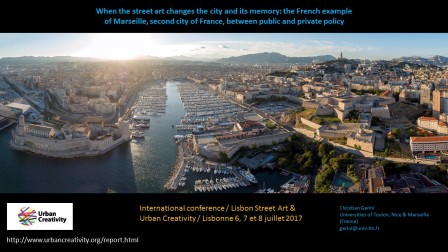"When the street art changes the city and its memory: the French example of Marseille, second city of France, between public and private policy" by Christian Gerini
International conference / Lisbon Street Art & Urban Creativity / Lisbonne 6, 7 et 8 juillet 2017
Marseille is the second most big city of France after Paris. It is also a harbour of tourism and trade opened on all the Mediterranean area and on the whole world. And it’s a racially very mixed area because of that and of the past colonies of France in Africa. Graffitis and other writings began to appear there at the beginning of the eighties, of course in an illegal way, first in the suburbs, on the trains, and very quickly on the walls of the city center that you can see on this photo.
I do not obviously have enough time to present you the story of the street art in Marseille. This one remains moreover to be writen. It is exactly one of the subjects which I am going to approach: the memory.
 But I will first speak about a big official realization along a great bypass road, with essentially a private funding (or private financing if you prefer): the bypass named L2.
...
But I will first speak about a big official realization along a great bypass road, with essentially a private funding (or private financing if you prefer): the bypass named L2.
...
I’m going to show you some projects about the memory of the history of graffitis and street art in Marseille and its region.
The book “La France d’en bas” which you see here is already a reference on the street art in all the South of France. But it is limited for three reasons. It concerns three important but rather distant cities: Toulouse, Montpellier and Marseille, only in a few years and it only shows photos of what did the artists concerned by these years and these cities.
And it is difficult to find people who took photos before the digital cameras and the smartphones appeared.
It is what says to us an artist seek313 who is going to publish a book about the history of the graffitis and the street art in Marseille and about the actors and the crews of this history for the last 35 years.
Here are his own words since we met him 15 days before and its project. I thank him here for the photos he gave to me in order to show this slide to you.
His own words, so:
__Graffiti appeared in Marseille in the 1980s. Like the city, it is raw, chaotic, spontaneous, aggressive, even dirty, fed by multiple influences. The city has long escaped all cultural and media, the local scene, rather minimal, was composed more or less of the same actors.
Graffiti exploded in the late 1990s. The oldest photos have been difficult to find: cameras at the time, authors who have more or less disappeared, lost archives ...
And unlike other cities, almost nobody was interested in that topic in order to document and illustrate it.
Since then, graffiti has become fashionable, it is omnipresent in the city, and has been recovered for a long time. Yet, all has not be done in one day: that's what we try to show through this book.__
...
Publié le jeudi 9 novembre 2017, par Christian Gérini